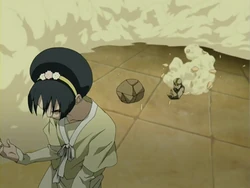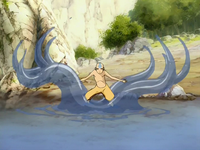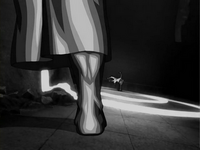- This article is about the martial philosophies. For the potion-maker, see Jing.
| "Listen to me, Aang. There are options in fighting, called jing. It's a choice of how you direct your energy." |
| — Bumi explaining the concept of jing to Aang.[1] |

Jing is a term that describes the myriad of options one has during battle on how to direct their energy, both internally and externally. Although Bumi claims that there are technically eighty-five distinct types of jing, the two commonly known forms are positive jing, corresponding to advancing or attacking, and negative jing, corresponding to retreating or evading. Another known form is neutral jing, which corresponds to waiting and listening, or, as Bumi described it, "doing nothing".[1]
Known types of jing
Positive jing

Positive jing is an aggressive expression of chi. As such, it complements the more aggressive tactics of firebenders during combat. Firebenders typically prefer action to inaction or conflict avoidance, relying heavily on preemptive strikes to overwhelm their opponents with sheer power. These positive jing attributes are also found in the attitudes and personalities that are common among the people of the Fire Nation.
While training Kyoshi in firebending, Rangi had the Avatar spar her on a long, narrow beam of earth to force her to concentrate on positive jing, resisting and overcoming rather than staying still and evading.[2]
Negative jing
Negative jing is mostly exercised in airbending, reflecting the Air Nomads' pacifistic lifestyle and their philosophy that all life is sacred; they assert that fighting is only to be used as a last resort when conflict cannot be avoided.[3] Airbenders are more mobile fighters compared to earthbenders and possess a highly dynamic fighting style; to "avoid and evade" is recognized as a typical airbender tactic.[4]
In the case of waterbending, common maneuvers involve following the moon and the ocean's example of "push and pull".[5] As such, waterbenders will alternate between and maintain a balance of both positive and negative jing in combat, allowing them to turn defense into offense as they use their opponent's force against them while conserving their own.
Neutral jing

Neutral jing is stated to be the key to earthbending. Fundamentally, neutral jing involves listening, though seemingly doing nothing, and waiting for the right moment to strike. When in combat, earthbenders are more stationary combatants, usually waiting for their opponent to come to them, while standing their ground and meeting their opponents' attacks head-on, before delivering a deadly strike of their own. Neutral jing forms the basis of true earthbending, and it is the concept used by the first earthbenders, the badgermoles. The idea is also fundamental in seismic sense, a perceptive fighting style used by select benders, one of whom was Toph.[6]
As highlighted, someone who has mastered neutral jing is someone who waits and listens before striking. Kyoshi demonstrated her knowledge of neutral jing when trying to de-escalate a situation where she was bullied by employing the principle of remaining as passive and unresponsive as she could while being bullied by Aoma, Jae, and Suzu.[7] Jianzhu mentioned the concept of neutral jing later as well when he was trying to track down Kyoshi, cautioning himself to over-prepare in favor of sitting quietly until the next step presented itself.[8] Bumi too relied on neutral jing while earthbending, to the extent that he refused to flee Omashu even when Aang came to his rescue. His desire to wait for an opportune moment to strike was initially baffling to his soldiers and to Aang, although the Avatar later accepted Bumi's decision.[1] The monarch eventually freed himself during the Day of Black Sun, recognizing it as the precise moment to strike as his captors were defenseless without their firebending.[3]
Trivia
- Jīng or Jīn (勁) means "power" or "energy" in Chinese (see also Fa jin).
- While the concept of neutral jing seemed to be common knowledge prior to the Hundred Year War, Aang had a hard time tracking down an earthbender around 100 AG who exhibited knowledge of the concept.
- While the concept of jing may be reflected as the differences of options open to a person in battle, it corresponds to all aspects of a person's life and not just on the battlefield.[7]
- A parallel to the series' concept of jing would be the "fight, flight, or freeze response" in psychology; certain personality types are more inclined to act in accordance with a particular jing.
- A dojo master on an island of the Southern Archipelago was known to incorporate all jings in their fighting style, not just the three most commonly known jings.[9]
References
External links
- Different spellings, pronunciations, and culturally-described definitions of the ancient term jing (勁)
- Nei Jin and Fa Jin, concepts similar to jing